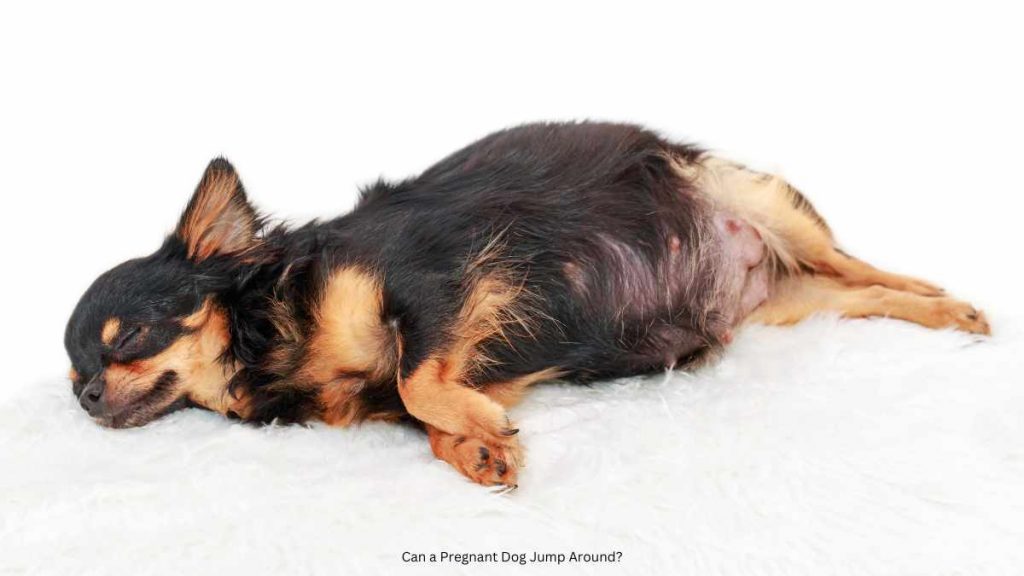Can a pregnant dog jump around? As a dog owner, it’s essential to understand the physical limitations and potential risks that come with a dog’s pregnancy. In this article, we will explore the stages of pregnancy, the physical changes dogs undergo, and whether jumping is advisable during this crucial time. Let’s delve into the topic and ensure the health and well-being of our pregnant canine companions.
Table of Contents
Can A Pregnant Dog Jump Around?
No, it is generally not recommended for a pregnant dog to jump around. During pregnancy, a dog undergoes physical changes such as weight gain and an altered center of gravity, which can make jumping difficult and uncomfortable. Hormonal changes can also affect ligaments and joints, increasing the risk of strains or injuries. Jumping excessively can pose risks to the mother and her developing puppies, including premature labor, miscarriage, or complications during birth. It is important to consult with a veterinarian for guidance on appropriate exercise and to provide a safe and comfortable environment for the pregnant dog.
Understanding Pregnancy in Dogs
Dogs typically have a pregnancy duration of around 63 days, divided into three stages: the first stage involves fertilization and early embryonic development, the second stage focuses on fetal growth, and the final stage prepares the dog for labor. During pregnancy, dogs experience various physical changes, including weight gain, mammary gland development, and an altered center of gravity.
Physical Limitations of Pregnant Dogs
During pregnancy, a dog’s weight increases significantly, which can affect its ability to jump. The additional weight and the redistribution of mass due to the growing fetuses can make jumping more challenging and potentially uncomfortable for the dog. Hormonal changes during pregnancy can also affect ligaments and joints, making them more prone to strains and injuries.

What are the Risks of a Pregnant Dog Jumping Around?
Jumping during pregnancy can pose several risks to the mother and her developing puppies. Excessive jumping can lead to strains or injuries to the joints and ligaments, causing discomfort and potential complications. It may also increase the risk of premature labor, miscarriage, or complications during birth. Therefore, it is generally advisable to limit jumping activities for pregnant dogs.
How much Exercise is too much for a Pregnant Dog?
Determining the appropriate amount of exercise for a pregnant dog depends on various factors, including breed, overall health, and stage of pregnancy. While regular exercise is important to maintain muscle tone and prevent obesity, excessive exercise can be detrimental to the dog’s well-being. Consulting with a veterinarian is crucial to establish a suitable exercise routine based on the individual dog’s needs.
Benefits of Exercise for Pregnant Dogs
Although jumping may not be recommended for pregnant dogs, moderate exercise can provide numerous benefits. Regular walks and gentle activities help improve blood circulation, maintain muscle tone, and promote mental stimulation. These exercises also help pregnant dogs manage their weight and reduce the risk of complications such as gestational diabetes.
What a Pregnant Dog Should Not Do
Apart from avoiding excessive jumping, pregnant dogs should refrain from rigorous activities such as high-intensity running, intense agility courses, or rough play. These activities can increase the risk of injuries or complications. It’s crucial to create a calm and safe environment for the expecting mother to ensure a healthy pregnancy.
Can My Pregnant Dog Play with Other Dogs?
While pregnant, it’s advisable to limit interactions with other dogs, especially unfamiliar ones. Uncontrolled play sessions can lead to accidental collisions or aggressive behavior from other dogs, potentially causing harm to the pregnant dog or her developing puppies. Close supervision and controlled socialization with known and friendly dogs are safer options during this sensitive time.
Tips for Exercising Pregnant Dogs
1. Consult with a veterinarian: Seek professional advice to establish an appropriate exercise plan tailored to your dog’s specific needs.
2. Gentle walks: Regular walks on a leash provide low-impact exercise and mental stimulation.
3. Controlled play sessions: Engage in calm and controlled play activities that avoid excessive jumping, roughhousing, or strenuous movements.
4. Swimming: If available, swimming is an excellent low-impact exercise option for pregnant dogs, as it reduces pressure on joints and ligaments.
5. Shorter and more frequent sessions: Instead of long exercise sessions, break them into shorter, more frequent intervals throughout the day to prevent exhaustion.
Tips for Keeping Your Pregnant Dog Healthy
1. Provide a balanced diet: Ensure your pregnant dog receives a nutritious diet suitable for her stage of pregnancy. Consult with a veterinarian for dietary recommendations.
2. Regular veterinary check-ups: Regular prenatal check-ups are essential to monitor the dog’s health, detect any potential issues, and ensure a smooth pregnancy.
3. Comfortable resting area: Create a quiet and comfortable space for the pregnant dog to rest and relax, ensuring she has easy access to fresh water and appropriate bedding.
4. Mental stimulation: Engage the pregnant dog in interactive games and provide toys to keep her mentally stimulated without excessive physical exertion.
Conclusion
In conclusion, while it’s natural to wonder if a pregnant dog can jump around, it is generally advisable to limit jumping activities during pregnancy. The physical changes and potential risks associated with jumping make it important to prioritize the health and well-being of the expecting mother. By following expert guidelines, providing suitable exercise alternatives, and creating a safe environment, we can ensure a healthy pregnancy for our beloved canine companions.
You May Also Like:

